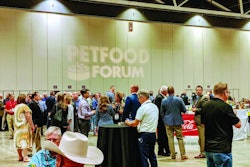
A majority of consumers globally, 55%, say they’re more likely to buy a packaged food item if it has a sustainability claim, according to a newly released FATtitudes survey from Cargill. The percentage is up from 51% in 2019, the last time the survey was undertaken.
As goes human food, so often goes pet food, meaning that this type of consumer sentiment likely carries over to our market.
More consumers influenced by sustainability claims
The most recent Cargill survey took place in summer 2021 and included responses from nearly 6,000 consumers. Among the countries where consumers were surveyed—Australia, Brazil, China, France, Germany, India, Mexico, Philippines, Russia, U.K. and U.S.—several saw double-digit increases in the share of consumers influenced by sustainability claims on packaged foods.
For example, Brazil and Mexico both experienced 13-point jumps, and in both markets, a large proportion of consumers are influenced by such claims: 74% in Brazil and 66% in Mexico. In India, the share rose 11 points, and now 67% of consumers there say they’re more likely to purchase packaged foods with sustainability claims.
The U.K. experienced an 8% jump, albeit a lower share of consumers, 51%, are influenced by these claims. That’s not as low as in the U.S., though, where only 37% indicate such an influence; that is a 6-point increase from 2019.
Besides asking about the influence of sustainability claims, the survey also asked what specific type of claims consumers seek. “’Sustainably sourced’ and ‘conservation of natural resources’ topped the list, ranking well ahead of more specific claims such as ‘fair trade, reduced packaging and fair/living wages’ in most every country included in the survey,” read a press release from Cargill.
The transfer to pet food proteins
How might this all translate to pet food? One key area lies with ingredients, particularly animal-based proteins. These often get a bad environmental rap, though their exact impact seems open to debate, mainly because it’s very difficult to track and accurately assess. Efforts are under way to do that, including the Pet Sustainability Coalition’s (PSC) “4-Factor Framework for Sustainable Protein Evaluation in Pet Food,” which involves measuring environmental impact, social impact, nutrition and animal welfare.
Other initiatives include various pet food life cycle analyses and tools used to conduct them, such as the multi-organizational effort in the European Union to develop product environmental footprint category rules released in 2018. These frameworks and programs may help pet food brands make the sustainability case for certain protein ingredients with claims or information that resonate with pet owners.
Of course, many traditional pet food protein ingredients, such as byproducts from the human food chain, have long been sustainable because they use parts of livestock animals that likely would go to waste otherwise. These are often rendered, and the North American Renderers Association (NARA) has been working to tell that sustainability story for some time now. (NARA researchers published a peer-reviewed scientific journal article in March 2021, for instance.)
The question is, do consumers see, understand and accept such stories?
Making a new case with meat byproducts
Some companies and programs are making sustainability claims by starting with just a few ingredients or product lines. Examples that come to mind include Shameless Pets, which bases all its pet treats on core upcycled ingredients (though not all are protein ingredients). Pet diets and treats made with insect protein can also base their brands and marketing on sustainability.
Yet more traditional protein ingredients can play a new role, too. At Auburn University, Charles Starkey, assistant professor in the university’s Poultry Science Department, conducts research projects with his graduate students to convert low-value poultry co-products—think wing tips, broiler carcass frames and woody breasts—into pet treats and jerkies. Not only does this aid sustainability, but it also provides a financial win for poultry producers, who normally earn only pennies per pound for such co-products. And, it helps Starkey teach his student about real-world, business applications of the concepts and field they’re studying.
(Starkey presented highlights of his research during a February 15, 2022, webinar, “Upcycling low-value proteins through the use of functional food technologies promotes sustainability while enhancing profitability,” sponsored and organized by Balchem. Several of Starkey’s students will also present during the Petfood Forum 2022 Student Program research sessions.)
Bringing consumers into the model
In a PSC webinar on February 10, 2022, a panel of experts discussed challenges and opportunities related to sustainable pet food protein. One panelist, Dave Carter, principal of Crystal Springs Consulting and a co-founder of Pet Promise pet food, raises bison and works with local livestock producers, including indigenous people. While he acknowledged traditional rendering of meat byproducts, he said that’s available mainly to larger pet food companies, and those rendered products don’t always fulfill efforts to source and trace locally.
Yet working with facilities run by tribal nations might help. “These are smaller facilities, so you’re not going to get that critical mass coming out of one facility, but there are real opportunities for us to do some things,” Carter said. “They can’t be ecologically sustainable unless they’re economically sustainable. The pet industry plays a really unique and important role in that,” he added, because it could help by buying and using byproducts that most smaller producers are currently not able to sell.
“When you look at it right now, the big processors only get pennies for the offal or byproducts—but they get pennies,” Carter continued. “Those smaller plants out there? Unfortunately, many times, they’re paying somebody to haul those ingredients to a landfill. And that’s the difference between profit and loss when you are in a real narrow-margin business. So the more that we can think about ways to work with networks of smaller producers to source those ingredients, we can flip that so the smaller processors that are doing things the right way [sustainably] can get pennies or even dimes so we can balance what we call the carcass utilization.”
As part-time director of the National Bison Association, Carter also spoke to the role education can play in bringing consumers into the sustainability model. “We’ve launched a program that we call Partner in Bison Restoration, which we’d love to get more pet food companies involved in, which is to tell the story that when we eat bison, when your pets eat bison, when you eat sustainably produced products, you’re creating the incentive for those farmers that produce those products.”
















